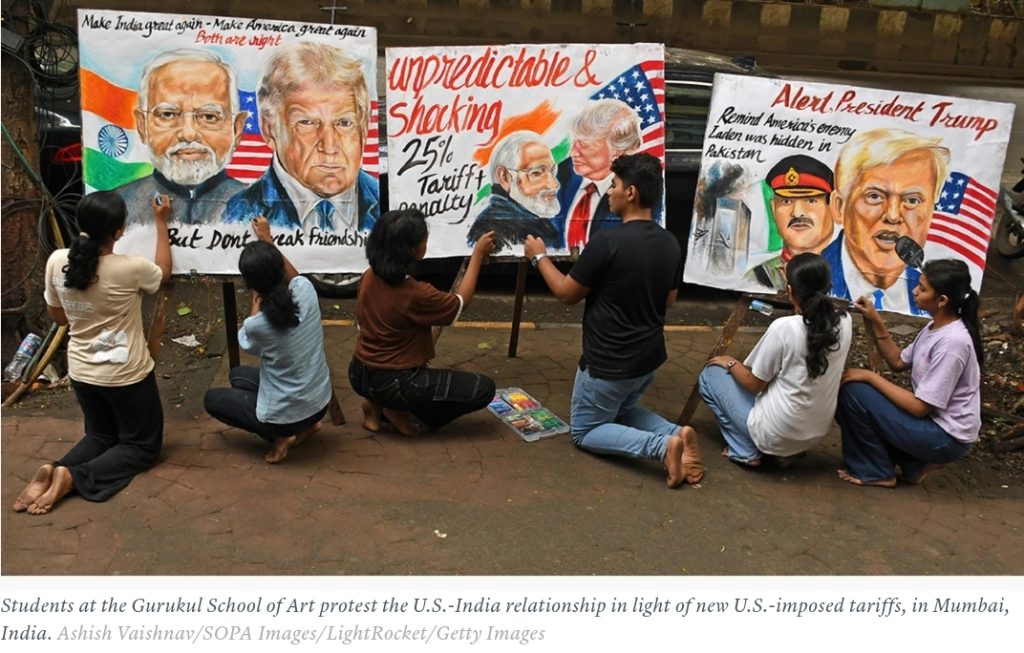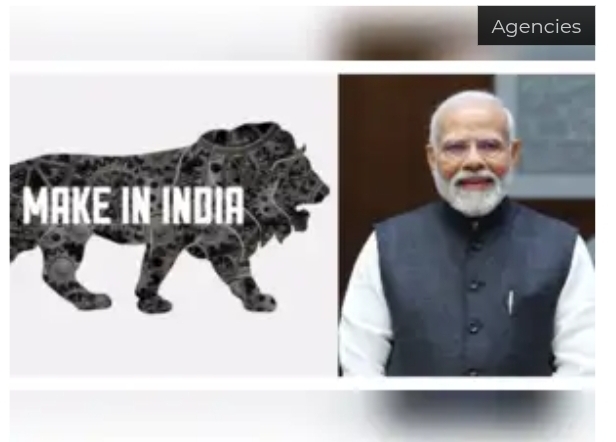India’s Economic Strategy Amid the US Trade War: A CX-Focused Analysis
Picture this: You’re shopping for a smartphone in December, and suddenly every Indian-made phone carries a 50% tariff when exported to the US. Meanwhile, your local grocery store owner in Gujarat proudly displays a sign reading “Only Made in India Products Sold Here.” This scenario isn’t hypothetical” it’s India’s current reality as the nation navigates unprecedented trade tensions with the United States while doubling down on domestic manufacturing. Vocal for Local is picking up fast.
The Trade War Escalation: Understanding the Stakes
The situation escalated dramatically when President Trump imposed a staggering 50% tariff on Indian goods, making India face the highest US tariff rate globally. This punitive measure stems from India’s continued purchase of Russian oil, which has surged to 2 million barrels per day in August 2025, representing 38% of India’s crude imports. Consequently, the US has labeled this relationship problematic amid the ongoing Ukraine conflict.
The tariff structure combines multiple layers: a 10% baseline duty, a 25% reciprocal tariff, and an additional 25% penalty specifically targeting India’s Russian oil purchases. These measures threaten approximately $87 billion worth of Indian exports to the US, with 55% of India’s US-bound shipments at risk[6]. Subsequently, critical sectors including textiles, gems and jewelry, leather products, marine exports, chemicals, and automotive components face severe exposure.
Furthermore, the scheduled sixth round of India-US bilateral trade agreement talks has been postponed indefinitely. The American delegation’s August 25-29 visit to New Delhi was cancelled, highlighting the deepening rift between the two nations. Indeed, this development dashes hopes for immediate relief from the escalating tariff war.
Modi’s Strategic Response: Vocal for Local Revolution
Prime Minister Modi’s response has been swift and decisive. Rather than capitulating to US pressure, he has intensified the “Vocal for Local” campaign, urging Indians to embrace domestically manufactured products. His message carries particular urgency given the economic backdrop and the approaching festive season.
The Prime Minister highlighted India’s remarkable manufacturing transformation. Specifically, India imported most mobile phones eleven years ago, yet today manufactures and exports 30-35 crore mobile phones annually. This success story demonstrates India’s potential for achieving self-reliance across multiple sectors. Additionally, Modi cited India’s Unified Payments Interface (UPI) as evidence of technological prowess, noting it has become the world’s largest real-time digital payment platform.
Moreover, Modi announced that India’s first fully made-in-India semiconductor chips will hit the market by December 2025. This announcement represents a significant milestone in India’s technology independence journey. The government has approved four new semiconductor manufacturing facilities in Odisha, Punjab, and Andhra Pradesh with a 4,600 crore investment. Consequently, these facilities will create employment opportunities for over 2,000 skilled professionals while strengthening India’s electronics manufacturing ecosystem.
Political Unity Against External Pressure
The trade tensions have prompted rare political solidarity across party lines. Punjab BJP President Sunil Jakhar called on all stakeholders to “set aside politics and stand united with Prime Minister Narendra Modi” for protecting Indian farmers against US market access demands. This unified stance demonstrates the gravity of the situation and the perceived threat to national interests.
Modi has consistently refused US demands for market access in India’s dairy and agriculture sectors. The agriculture sector employs 54.6% of India’s total workforce, while agriculture and allied activities account for 18.4% of the country’s Gross Value Added. Similarly, India’s dairy industry, valued at 18.9 billion in 2024, employs eight crore people. Therefore, any compromise on these sectors would have massive political and economic ramifications.
The US demands include reduced tariffs on corn, soybeans, apples, almonds, and ethanol, plus increased access for dairy products and genetically modified crops. However, Modi has drawn a clear red line, declaring he will “stand as a wall against any harmful policy concerning farmers, cattle-rearers, and fishermen”. Consequently, he emphasized that India will never accept any compromise regarding these critical sectors.
Economic Impact and Market Dynamics
The tariff war’s economic implications extend far beyond bilateral trade statistics. India’s mobile phone exports, which surged 74% year-on-year to $3.09 billion in May 2025, face significant headwinds. These exports represent the second-highest monthly figure ever recorded, just behind March 2025’s $3.1 billion peak. Nevertheless, the 50% tariff threatens to make these exports economically unviable.
India’s transformation in mobile manufacturing has been remarkable. Mobile phone exports grew from 1,500 crore in 2014-15 to 2 lakh crore in 2024-25, marking a 127-fold increase. Similarly, mobile phone production expanded from 18,000 crore to 5.45 lakh crore during the same period 28-fold rise. However, these gains face serious challenges under the current tariff regime.
The Russian oil trade adds another layer of complexity. India imported 88 million tonnes from Russia in FY25, representing 35.1% of total oil imports. This relationship has helped India maintain energy security while potentially saving billions in import costs. Nevertheless, the US views this trade as indirectly funding Russia’s war efforts in Ukraine.
Digital India’s Global Leadership
Amid trade tensions, India’s digital payment revolution continues gaining momentum. UPI now processes over 640 million transactions daily, surpassing global giants like Visa. The system powers 85% of India’s digital transactions and nearly 50% of global real-time digital payments. Furthermore, UPI is operational in seven countries, with its entry into France marking a significant European expansion.
This digital infrastructure success demonstrates India’s capability to build world-class systems independently. UPI’s monthly transaction volume reached 18.39 billion in June 2025, processing 24.03 lakh crore in value. Additionally, the platform serves 491 million individuals and 65 million merchants, connecting 675 banks through a unified system. Therefore, UPI represents a powerful example of India’s technological self-reliance.
Consumer Behavior and Cultural Transformation
The “Vocal for Local” campaign has significantly influenced consumer behavior patterns. Research indicates that over half of consumers report changed perceptions of local brands following the campaign. Moreover, feelings of empowerment and empathy toward local businesses influence purchasing decisions more than patriotism alone. Consequently, 36% of consumers are likely to recommend local brands, while 38% remain detractors.
Regional marketing has become increasingly important as brands recognize India’s diverse market characteristics. The campaign has evolved beyond merely promoting Indian-made goods to connecting consumerism with culture. Successful brands are pivoting toward strategies that celebrate India’s regional nuances rather than simply translating advertisements into local languages. Therefore, understanding and embracing each region’s unique characteristics becomes crucial for market success.
Manufacturing Renaissance and Self-Reliance Vision
India’s manufacturing sector has experienced remarkable growth under the Make in India initiative. The campaign, launched on September 25, 2014, aimed to increase manufacturing’s GDP contribution from 15% to 25%. Foreign Direct Investment in manufacturing reached $165.1 billion over the past decade, marking a 69% increase. Subsequently, this growth has attracted international confidence in India’s manufacturing capabilities.
The semiconductor sector represents the next frontier in India’s manufacturing journey. The government has approved ten semiconductor projects with cumulative investments of 1.60 lakh crore across six states. These initiatives target applications in defense, electric vehicles, solar power, telecommunications, automotive, and railway sectors. Consequently, India aims to capture a significant portion of the global semiconductor demand, which currently relies heavily on Taiwan and other Asian nations.
Strategic Questions for India’s Future
As we analyze India’s position in this evolving trade landscape, three critical questions emerge that will shape the nation’s economic trajectory:
Question 1: Can India Successfully Decouple from US Markets Without Compromising Growth?
India’s challenge lies in maintaining economic growth while reducing dependence on US markets. The country’s bilateral trade with the US reached $190 billion in 2024, with America being India’s largest trading partner. However, the 50% tariff essentially functions as a trade embargo, threatening to halt affected product exports entirely.
The answer lies in India’s ability to diversify markets and strengthen domestic consumption. India’s growing middle class and increasing purchasing power provide substantial internal demand. Additionally, expanding trade relationships with BRICS nations, Southeast Asia, and Europe could offset US market losses. The UPI expansion into multiple countries demonstrates India’s capability to create new economic partnerships.
Nevertheless, decoupling requires careful management of short-term pain for long-term gain. Industries must invest in productivity improvements and innovation to remain competitive. Government support through PLI schemes and infrastructure development will be crucial. Ultimately, success depends on India’s ability to transform from an export-dependent economy to one driven by domestic consumption and diversified global partnerships.
Question 2: Will the Vocal for Local Campaign Create Sustainable Competitive Advantages or Result in Economic Isolation?
The Vocal for Local campaign’s success hinges on creating genuine competitive advantages rather than protectionist barriers. India’s mobile manufacturing transformation provides a positive example the country evolved from 78% import-dependent in 2014 to manufacturing 99.2% of phones sold domestically by 2023. This shift occurred through strategic investments in capabilities, not just import restrictions.
The campaign’s sustainability requires continuous innovation and quality improvements. Indian manufacturers must compete on merit, not just patriotic sentiment. Consumer surveys indicate that price parity remains crucial most consumers would buy local brands only if priced similarly to international alternatives. Therefore, the campaign must drive efficiency and innovation, not complacency.
Economic isolation remains a real risk if the campaign becomes purely inward-looking. Global value chains require integration and specialization. India’s semiconductor strategy acknowledges this reality by partnering with international firms while building domestic capabilities. Consequently, the optimal approach involves selective self-reliance in strategic sectors while maintaining global competitiveness.
Question 3: How Will the Agriculture and Dairy Sector Stance Impact India’s Long-term Trade Relationships?
Modi’s firm stance on protecting agriculture and dairy sectors reflects both political necessity and economic reality. These sectors employ over 54% of India’s workforce and generate substantial political influence. However, this position complicates trade negotiations with multiple countries, not just the US.
The challenge involves balancing farmer protection with trade opportunities. India’s rejection of genetically modified crops and resistance to dairy market opening stems from legitimate concerns about food security and rural livelihoods. Small-scale Indian farmers cannot compete with highly subsidized Western agriculture in an open market scenario. Therefore, protecting these sectors appears economically justified.
Nevertheless, this stance may limit India’s access to other trade benefits. The US demands represent broader patterns in international trade negotiations. Finding middle ground perhaps through gradual, conditional market opening or sector-specific arrangements could preserve farmer interests while maintaining trade relationships. The key lies in negotiating from strength rather than weakness, leveraging India’s growing market size and technological capabilities.

Conclusion: Navigating Uncertainty with Strategic Confidence
India’s response to the US trade war demonstrates strategic thinking beyond immediate economic calculations. By intensifying domestic manufacturing focus while maintaining energy security through Russian oil purchases, India signals its commitment to independent decision-making. The country’s digital payments leadership, upcoming semiconductor manufacturing, and mobile export success provide evidence of successful self-reliance strategies.
The path forward requires careful balance between nationalism and pragmatism. India’s large domestic market provides cushioning against external shocks, while growing technological capabilities offer new competitive advantages. However, complete isolation would harm long-term growth prospects. Therefore, selective engagement, strategic partnerships, and continued innovation represent the optimal approach for navigating this challenging period while building sustainable economic strength.
Ultimately, India’s current strategy reflects confidence in its long-term potential rather than defensive reaction to external pressure. The Vocal for Local campaign, semiconductor ambitions, and agricultural protection policies demonstrate integrated thinking about economic security. Whether this approach succeeds will depend on execution quality and the global community’s response to India’s assertive economic nationalism.

